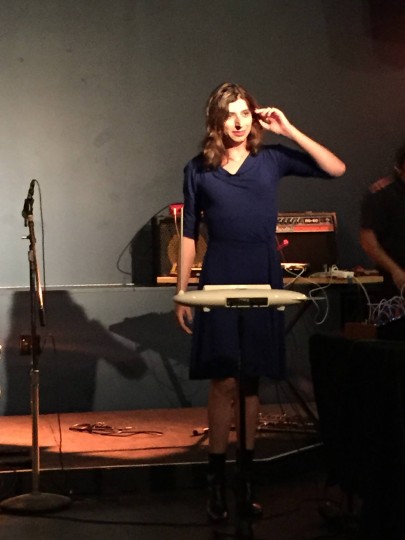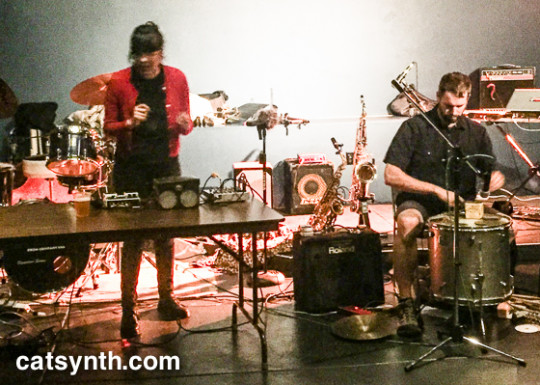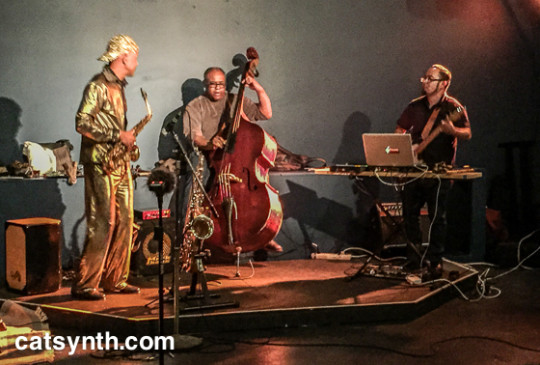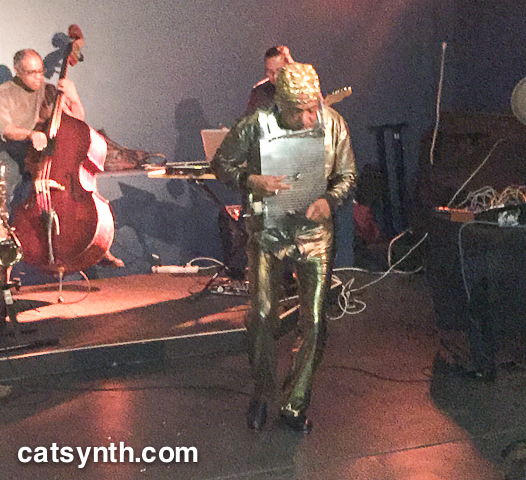
Another photo of the beautiful Nora, the piano-playing cat. Submitted by AnalogKeys (originally from Femme Abstruse) via Twitter.
“♡ॢ₍⸍⸌̣ʷ̣̫⸍̣⸌₎”


Another photo of the beautiful Nora, the piano-playing cat. Submitted by AnalogKeys (originally from Femme Abstruse) via Twitter.
“♡ॢ₍⸍⸌̣ʷ̣̫⸍̣⸌₎”

A tribute to Ornette Coleman from J.B. of the Mensa Cats.

By Geert Vandepoele (Ornette Coleman) [CC BY-SA 2.0], via Wikimedia Commons
In addition to his composition and playing, he was an accomplished band leader, bringing together disparate performers to play complex music that remained rhythmically tight. There was the Ornette Coleman Quartet that cemented his reputation as an experimenter, and later his band Prime Time, which took on electronic elements and fusion idioms while retaining oblique rhythms and counterpoints.
I also find myself identifying the descriptions of him as soft-spoken and taking a deeply intellectual (perhaps bafflingly so) approach to describing music. Many jazz greats are sons and daughters of the South, and Ornate Coleman was no exception – but it is interesting to see him and others transcend that heritage to something of a different time and place, or perhaps no particular place at all. We should follow his example and keep jazz an alive, evolving, and often challenging music.
Today we look at a recent performance by Amy X Neuburg at the Center for New Music featuring a new interpretation of Jerry Hunt’s “Song Drapes.” This project was part of commission Neuburg received from the Cultural Department of Cologne, Germany to reinterpret the piece, which was originally a collaboration between Hunt and the performance artist Karen Finley.
We at CatSynth are immersed in a world of unique and often odd artists. But Jerry Hunt stands out as exceptionally odd and enigmatic. The evening began with screenings of his video work that is rarely shown in public. Many of them featured the artist alone in a dark room with his strange homemade electronic controllers and bits of electronic sound.

There were other departures among his videos, including one powerful piece featuring a close-up of Hunt reciting what seems like a stream of random but intense thoughts; and other where he takes the viewer on a tour of his home in Texas pointing out the behavior of local wildlife and a customized homebrew toilet. Both of these pieces seemed to portend his tragic death by suicide while suffering from cancer. But there were also humorous at times.
A similar mixture could be found in Neuburg’s live performance, which followed the screenings. “Song Drapes” includes Hunt’s original electronic background recordings and instructions to the performer to perform text of his or her own choosing with a live percussion rhythmic layer. The elements of electronics, percussion and voice were a perfect match for an “Amy X Neuburg treatment.”

The result was unmistakably her sound and style, filled with rhythmic hits, dramatic vocals and delightfully sardonic texts. Some were quite dark in keeping with the original work, but some of the best moments were the most quirky and humorous, including a tribute to Nebraska as the place one often flies over between frequent trips between California and New York (something which is part of my life as well), and her dance to a catchy rhythmic tune entitled “Little Legs”.
The performance lasted exactly one hour, but was engaging throughout. I am glad to have attended it. I do also hope to see more exposure for Jerry Hunt and his work. You can read more about him here. You can also find out more about Amy X Neuburg’s interpretation
The acclaimed French band Magma recently toured the United States for the first time in quite a long time. And we at CatSynth were in attendance when the played at Slims in San Francisco about a month ago.

For those not familiar with Magma, it was founded in France in 1969 by drummer Christian Vander. Musically, the band combines some of the best aspects of jazz fusion and progressive rock from the early 1970s with a unique (and somewhat apocalyptic) vision. All the the lyrics are written in Kobaïan, a constructed language invented by Vander that reflects the story from the band’s first album in which settlers fleeing Earth settle on a planet Kobaïa. The vocal arrangements feature a mixture of complex solo vocals and rich choral sections, all the while backed by Vander’s drumming and intricate rhythm from the full band.

The overall energy level was intense to say the least, but the thing I noticed most was how tight they were at all times throughout the performance. This is especially key for the fusion aspects of their music, and something that I found quite inspiring. Take some of the more fast-paced and intricate examples from Herbie Hancock’s early 1970s bands, and layer the vocals on top with punctuated rock hits. Although these elements can be found in other bands of the era, there is something distinct about their sound that made it immediately recognizable upon entry to the venue (we were slightly late and they had already started the first song). It is also interesting to note that the music has a very optimistic quality (and a bit of exuberance) that belies the rather dark theme of the lyrics and concept for the band.

Magma played to a packed house that evening. Slims is not a large venue, but it’s not the smallest either. There were definitely a lot of long time fans who clearly recognized the songs, but I’m sure some new listeners discovered them and hopefully went away wanting to hear more of them. For the overall experience and the musical inspiration, I am quite happy to have been in attendance.
As Pitta of the Mind prepares for our upcoming show next week, we look back at our last show in February at Outsound’s periodic Soundspeak series featuring experimental music and poetry groups.
For our set we performed several new pieces on the theme of film, with several poems evoking treatments and plots for possible (or impossible) films. The music featured a mixture of piano, Moog Theremini, modular synth and DSI Prophet 12, which made for quite an impressive setup.

As with most Pitta of the Mind shows, we had a color/pattern theme. On this evening the theme was white.



[Photos by Annabelle Port. Click to enlarge.]
The performance overall went quite well. You can here some audio excerpts below.
We were proceeded that evening by a trio featuring Nick Obando with Rob Pumpelly and Eli Wallace. The group performed several extended-length jazz pieces layered with Obando’s hip-hop-infused poetry.

I have to admit I do not recall much of the words/poetry, but the instrumental performance was quite memorable. I am a fan of Eli Wallace’s keyboard performance style, and Pumpelly and Obando brought their own strong technical skills to the mix. I particularly liked one piece that featured a funk rhythm with complex solos and patterns on top. The rhythm cut out in a few spots for freeform improvisation that was just long enough before returning to the funk pattern.
Overall, it was a good show, though a quiet night – possibly a combination of other performances happening that evening and the fact that the Luggage Store Gallery is at a temporary location while the main building is being renovated. But we certainly look forward to performing again, and hearing more music in the meantime.
Today we look back at a memorable show I played in a couple of weeks ago at Second Act here in San Francisco. Four acts each brought a different style of performance, instrumentation and experimentation to the stage.
First up was IMA, an electro-acoustic duo featuring Nava Dunkelman and Jeanie-Aprille Tang. Their sound blends the noisier edges of percussion with a range of electronic sources, including loops, samples, and percussive hits that complement the acoustic sources. It was a loud and intense affair, but with quiet sections. Dunkelman also used her voice during the performance as another instrument.
Then it was time to take the stage. This was another set featuring Moog Theremini and analog modular synthesizer. The color theme for this performance was blue.

[Photo by Tom Djll]
As with many of these electronic improvisation sets, it starts off very structured and then moves in different directions based on the audience, room, instrument behavior and inspiration. You can see the full performance in this video.
Amanda Chaudhary at Second Act from CatSynth on Vimeo.
Overall I was quite pleased with the performance and the audience reaction.
Next up was Voicehandler, a duo of Danishta Rivero and Jacob Felix Heule.

Their sound was a bit more subtle than the previous acts. It featured Rivero on extended vocal techniques with a water-based electro-acoustic instrument of her own invention, the Hydrophonium; and Heule on extended percussion techniques that were often subtle and precise before veering into more energetic territory.
The final act was a quartet led by Idris Ackamoor featuring Mark Heshima Williams on bass, Bob Marshall in drums, and David Molina on guitar and laptop with Ableton Live!

Several of the musicians and musical pieces were familiar from Ackamoor’s renowned “afro-futurist” group The Pyramids. Indeed, the performance followed a similar structure with both a rhythmic entry and recessional. The rhythm section of Williams and Marshall was solid and perfect for some of the funkier grooves; and Ackamoor managed to move effortlessly between roles as horn-player and solo tap-dancing. It was interesting to hear David Molina and his guitar+electronic work, which I have heard before as a solo project, blended into this context.

All together it was a good show from all four groups, a diverse range of music. The large audience seem drawn to all the acts even if they initially came following one. And it’s great to see spaces like Second Act continuing to host shows like this in San Francisco. I hope to play there again sometime soon.